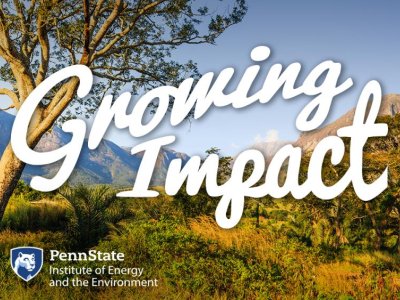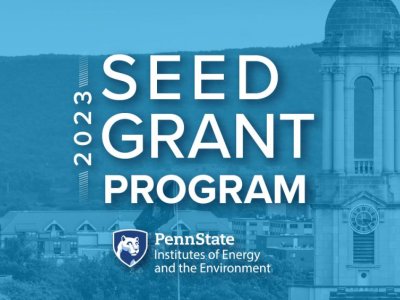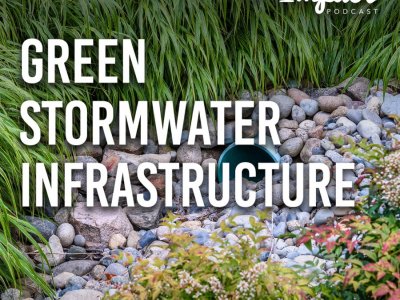38-minute listen/watch | 18-minute read | 1-minute teaser
Malawi, like many countries in Africa, is facing environmental challenges including deforestation, soil erosion, and unsustainable farming practices. However, restoring the land is much more complex than planting additional trees. The degradation of the land is closely related to the socio-economic status of the people of Malawi, who are connected to the land through agriculture as well as social, cultural, and religious traditions. While Malawi has pledged to restore degraded lands, it is not clear if any efforts are accomplishing what they intended. A research group is using Malawi as a case study to better inform policies and practices in forest landscape restoration.
Transcript
Intro: In Africa, we have 34 countries that have pledged to restore their lands, and all of them have committed millions of hectares that they want to restore, which is good. Some of them—and there are different levels of implementation—some of them have started with projects, others are even yet to start. So we want to use the case of Malawi, which is one of the champions of, we say, in restoration.
Host: Welcome to Growing Impact, a podcast by the Institute of Energy and the Environment at Penn State. Each month, Growing Impact explores the projects of Penn State researchers who are solving some of the world's most challenging energy and environmental issues. Each project has been funded through a seed grant program that's facilitated through IEE. I'm your host, Kevin Sliman.
Host: Malawi is a sub-Saharan African nation in the southeast section of the continent with a population of about 20 million people. The country is heavily dependent on agriculture. In fact, four out of every five Malawians work in the agriculture sector, and they're dependent on the land. However, the land in Malawi is deteriorating. Forest loss, soil erosion, and unsustainable farming practices are depleting the land. Still, Malawi is a leader in terms of forest landscape restoration. The country has pledged to restore thousands of square miles of land. With the goal of informing restoration policy and practice, a research team looks to measure restoration efforts and understand what those efforts are achieving, including ecological changes, socioeconomic benefits, and governance improvements.
Ida Djenontin: Hello to everybody. My name is Ida Djenontin. I am an assistant professor in the Geography Department at Penn State University. I'm a human environmental geographer and mostly interdisciplinary trained environmental social scientist. My research, right I focus on interlinked environmental and climate change issues that affect mostly forest and agricultural systems. And in that, I looked at the governance aspect, the institutional, social, cultural, and economic dimensions of environmental degradation and resource conservation and restoration now. All that in the context of climate... changing climate context. So also looking at how this affects adaptation and mitigation, but mostly in sub-Saharan African countries.
Tong Qiu: So my name is Tong. I'm an assistant professor of multifunctional landscapes, this is in landscape ecology. I'm an assistant professor in the College of Agriculture Sciences Department of Ecosystem Science and Management. I'm using remote sensing data to understand how global change affects the ecosystem function and services of global forest and other ecosystem types.
Judith Kamoto: Hello everyone. I'm Judith Kamoto from Malawi. I work with the Lilongwe University of Agriculture and Natural Resources. I'm a development sociologist by training, but I also studied forestry in its entirety. So currently I'm a college director for Bunda College of Lilongwe University of Agriculture and Natural Resources. I'm an associate professor of forestry and rural development. My research revolves around community forestry, governance issues in forestry, forest landscape restoration and gender, climate change—almost I’m a jack of all trades but focusing on natural resource management. I'm trained as a social and natural scientist, so I combine those two in my field of research.

Host: This project is focusing on sub-Saharan Africa, and it's looking at environmental degradation. Could you help me understand what's happening across sub-Saharan Africa in terms of environmental degradation?
Judith Kamoto: Environmental degradation is really a problem in Africa, in particular Malawi. Most of the natural resources that remain on the continent are being degraded either for social or economic activities. Most of the tree species that we have that are of value, they're being cut for timber to provide wood to the industry. So the countries like Democratic Republic of Congo, Gabon, Cameroon—that belt still has rainforest in Ghana and some parts of West Africa. But those countries that have a savanna type of forest or Miombo forest in Southern Africa, most of that is being degraded because of the community’s dependence on those forests. So they depend on forest for livelihood. So firewood for cooking, charcoal for cooking and heating, fruits, even wildlife, it depends on the same forest. Like elephants, they'll browse on trees and elephants, normally, they're very destructive in their sense of browsing. So you find that because of that, most of the environment is being degraded. But as, again, not just looking at forests, but the environment in general.
Our way of farming is also degrading the soils that we have. Most of the soils are very in infertile because they've been farmed for a very long time using inorganic fertilizers. So it's now that people are talking of using organic fertilizers so that then the structure of the soil can improve. But because we have also lost vegetation through deforestation or forest degradation, whenever it rains, there's quite a lot of runoff, and the runoff carries the soil to the rivers. And the rivers are polluted because of that runoff. So it's estimated that in Malawi alone, we lose about 70 tons of soil every rainy season. Environmentally, its water is polluted because of the soil. The soil is itself degraded. The forests are degraded because of livelihood support. And in addition, the air is polluted environmentally because our agriculture relies on burning the residues when we are trying to start making ridges in readiness to plant crops. So we put fire to those residues. And that also pollutes the air. Of course, because of the trees are gone in most parts of the cities, there's also a lot of dust and the air is polluted. But the worst enemy environmentally that we are facing at the moment is also management of waste. So management of waste—bottles, plastic bottles, plastic carrier bags. We have not moved yet into the organic type of carrier bags. There's quite a lot of environmental degradation. If I may put it in short, these are emphasized in Malawi, but I think they cover most of the continent.
Ida Djenontin: That's completely true. Judith surveys the whole, lots of issues that we have as in environmental degradation across sub-Saharan Africa, giving specific example from Malawi. But if I come back to the agricultural and forest sector, like she said, we have evidence of steep declining forest rate, of forest loss. And now it's no longer subjective because we have tools that are measuring that forests are... we are really losing forest, the rate of forest, both degradation and deforestation. In terms of the drivers, I want to also add to what Judith said. She mentioned timber, by timber use for wood. We also have, especially for sub-Saharan Africa and low-income countries in sub-Saharan Africa, small-scale agriculture is understood as a driver of deforestation. And also the reliance on charcoal as energy source. So biomass-based energy, which is also putting pressures on forest. So, but one thing that we tend to emphasize that those drivers of deforestation or that type of deforestation is not permanent, which means there is potential to reverse the tendency, and they don't lead to permanent deforestation.
Host: Are there any other thoughts about why it's occurring across sub-Saharan Africa? Any other thoughts about environmental degradation?
Judith Kamoto: Why is it happening? I think for sub-Saharan Africa largely is because of the socioeconomic situation in which most people find themselves. So the levels of poverty are high, that the only way out to any income is through forest products. But the forest products that can earn them more money is not the non-timber forest products, like fruits, but the actual wood. And that's why there's quite a lot of cutting for firewood because they can take that firewood to urban areas for sale to earn any little bit of income. And charcoal is the most usable form of energy in urban areas. And where you have these forests very close to urban areas or cities, then these local communities, even those from the urban, they go and stay and cut and bring the charcoal to urban or cities to earn income. So whether it's the subsistence agriculture that they rely on because the soils are degraded, they'll need an organic fertilizer. They're not cheap. So they'll need a hectare and hectare of, forests to make three bags of charcoal, which would earn them maybe half the price of one bag of fertilizer, which is not enough for one hectare or half a hectare of maize or corn. So yeah, it's the levels of poverty that are really driving deforestation and also population growth. And most of the sub-Saharan African countries, the population is really growing fast. And also maybe education levels from Malawi also, that is also a factor. The majority of Malawians live in rural areas, and they're not educated. So interventions that will bring or reverse environmental degradation also require people who can comprehend their culpability. But most of the population is not educated.

Host: The things that are happening because of the degradation. Again, we talked a bit about... we're kind of touching on these things, but I don't know if there are more specific, either specific examples you'd like to talk through about what is being impacted by the degradation of the land. I mean, obviously people are very impacted by the degradation of the land. Are there other things that you would love to bring that, that you would like to bring up because... due to that degradation?
Ida Djenontin: Yeah. So from all those things that we pointed out as being the drivers of deforestation or even deforestation happening or environmental degradation happening, once you understand that people live out of those resources, you then understand that when those resources are being degraded, then people are impacted. So livelihood of people, especially people living in rural areas, are impacted by environmental degradation, be it forest... be it deforestation, land degradation, soil erosion, all of that. And because in sub-Saharan African countries are still their economy are still rural. What I mean by that is that they're still based, I mean, yeah, the economic activities are from the primary sector, which is agricultural, forest products. So, but those are the one being impacted by environmental degradation. So then those livelihoods are really impacted as well. We also have biodiversity. So habitats are being... we lose biodiversity, be it plant biodiversity or animal biodiversity, because the habitats of those beings, are being lost with degradation, with deforestation. So that's also another element I think, Tong, you wanted to add to that?
Tong Qiu: Yes, I was just talking about the biodiversity. So basically every single species group, like small mammals, birds, and other like large mammals, they'll be under the impacts of climate warming. So some species can move around, they can find shelters in different places. But habitat degradation remove those shelters, so they won't be able to find places that can mitigate climate warming impacts. Those also would have huge impacts on their life history at different, like how they can raise their offspring, how they can increase their population abundance. So those will have a large impact. And therefore, habitat degradation also will influence the quality of their forest or their shrubland. So the degradation of soil will cause a phenomenon called woodland encroachment. So basically all those good quality shrubland will be replaced by grassland. So, which means they'll lose lots of habitat for different variety of community that the forest and shrubland support.
Host: Could you discuss and tell us about what forest landscape restoration is, and what does it hope to accomplish, or what does it look to accomplish?
Ida Djenontin: So there is a whole history with what is now packaged as forest and landscape restoration, but we will just go with the current definition that we have for it, which is an approach to restore and reclaim degraded ecosystems toward bringing back the ecological functionalities that are important for both human wellbeing, but also ecological wellbeing. And unpacking a little bit more is that if we... it's about any types of restoration activities that can help us to restore the ecological status, the biophysical aspect of a landscape, but also the ecosystem services on which people depend. So it has not only a natural component, which is the restoration of the ecological habitat and other biodiversity aspect, but also some social outcomes that are important to incorporate. And we also tend to in a climate change lingo, we say forest landscape restoration is also a natural climate solution because what we expect to have from forest landscape restoration is also meant to support adaptation and mitigation, mitigation in the way that forest landscape restoration can help us to increase carbon sequestration in forests. If forests are back or in soil, if soil are back... are restored. So, but it is a means to many end. So it's an intervention or a suite of interventions, a package of interventions, depending on the context where you are, whether tree planting, whether assisting natural regeneration, whether learning water conservation practices, what we package as sustainable land management. So the interventions that fall under forest landscape restoration are various and that it's not just a one size fits all as tree planting. And most importantly, it has to not only achieve ecological outcomes, but also social outcomes.

Judith Kamoto: I just want to emphasize the point that the benefits are many—the benefits to the ecosystem, benefits to social beings, benefits to cultural or religious, especially this side of the continent, these things matter a lot. So there's quite a variety of benefits that we derive from restoration. And most importantly, what she mentioned about a restoration is a means to adaptation to climate change as well as a mitigation to climate change, which is a global problem
Tong Qiu: About the regeneration part. So we can use remote testing to monitor the progress of regeneration through time, but we cannot, you know, we can guide it. The remote sensing approach can guide which places is easier to regenerate the forest. But in terms of initializing the plan, we still need the policy on the ground instead of using... remote sensing can just be a tool to monitor the process, but not the one to initialize the whole process. That's my take.
Host: What does climate change look like in Malawi?
Judith Kamoto: So climate change in Malawi manifests itself through the rainy season that we have. We have observed that the onset of the rains have shifted over time. We used to have the beginning of the rainy season in October of every year, but now we have the rains in December, so there's late onset of the rains. Sometimes it's as late as early January. But we only have three months of rain to make agriculture happen because our agriculture is mostly rain-fed. It's not irrigation. And it's not that we don't have rivers that we can do irrigation, but irrigation is expensive. It's only affordable to a few. So with the late onset of the rains, and sometimes the secession of the rains is also early. So a normal rainy season is three months, four months maximum, but sometimes we have three months. What does that mean? If you have late-onset of the rain at early cessation, and in the middle of it you have droughts or dry spells, it means that productivity of the land is not what you expect. The yields are very minimum. And Malawi is an agri-based country, so we rely on agriculture. So if we don't have the rains that we rely on because of climate change, then that's a problem. It means that people will go hungry, they'll be famine in that year. So within a four-month period of rainy season, we really don't want to see droughts, but that's a manifestation of climate change. We don't want to see dry spells because that's a manifestation of climate change, but we see them, and these days we see them more frequent. The other face of climate change within the same period is that sometimes we have too much rain or okay, if it's too little, maybe it's drought or dry spells, but too much rain will result in flooding. And for the past 10 years, every rainy season we have had a disaster, which is as a result of the rainy season being in progress, either through cyclones—like this year we had Cyclone Freddy, which came around March towards the end of the rainy season, but it was very destructive. That is something that we cannot plan for, but it's something that is coming with the winds and with whatever is happening in the Indian Ocean, and we just get the effects of it. But we rely on the winds themselves to bring us rain, because if they don't bring us rain, then we are in problems. So to me, I would say that climate change in Malawi really is very vivid during the rainy season, but it's also hot. And in certain districts where it's not as hot as it used to be, and now it's getting hotter and because of that, diseases like malaria because they like warm areas, but also wet, you've seen an increase in those vector diseases that either come in because of the temperature changes. And also the other thing is that now it's the cold season. Our cold season in the past used not to be very much, but now this is July, it'll be drizzly and yeah, we are now putting on winter jackets, like in tempid regions. So it's something that a person of my age would say we use not to do that, but yeah, we can also see it in temperature in terms of how cold it has become. Sometimes the minimum temperature early in the morning is nine degrees (Celsius). We never used to have nine degrees temperature before. Yeah. But the, the manifestation is really in the rainy season.
Host: Let's talk about the project. What is the project focusing on and what does it look to do?
Ida Djenontin: Yeah, so we were talking about forest landscape restoration, right? So in Malawi, as in many other countries, there are interventions. So what, like projects implementing different forest landscape restoration interventions. Having studied what is forest landscape restoration in the past, and now we have actual projects on the ground doing implementation. Our question here is to understand what they're actually achieving. And taking Malawi as a country case study, we want to understand what restoration is achieving on the ground, if any, and when we mean what is it achieving, we said restoration is about ecosystem, it is about people—so the social—but also is about changing different institutions that are part of the governance that helps to manage those resources. We want to understand all of that to keep informing restoration as a policy. whether it's not that it is worth, it is worth restoring, but are we achieving what we are expecting? That's important. So one way of doing that is to go and measure different types of indicators. Now, there are a bunch of indicators that restoration implementers look after, but they also overlook other indicators, especially the social indicators and also the institutional changes. So this project will not like— what many think about restoration—oh, the landscape will be restarted. So we are going to look at the ecological changes. We are going to look at the biophysical changes, we're going to look at carbon sequestration, obviously. We'll look at all of those, and when we add the social outcome, we'll define what indicators are best to measure the social outcomes of restoration, and also what indicators are best to capture the changes in institutions and the changes in the governance. So that's what we are going to look at. So, we start first with reviewing a bunch of those indicators, the ones that are available, and also thinking about the ones that are not available that we can think of. So that will be a first part and then set up hopefully a big proposal where we make the case for the importance of measuring water restorations is achieving under the ground. In Africa, we have 34 countries that have pledged to restore their lands, and all of them have committed millions of hectares that they want to restore, which is good. Some of them—and there are different levels of implementation—some of them have started with projects, others are even yet to start. So we want to use the case of Malawi, which is one of the champions of, we say, in restoration.
Host: In Malawi, is policy a big barrier to this at this point, or is it something that's actually aiding in it, or is it a neutral, a neutral thing at this point?
Judith Kamoto: So the policy environment is very conducive in as far as land forest landscape restoration is concerned.
Ida Djenontin: When Malawi pledged to restore their land, their degraded land, they followed up with elaborating what they call the national strategies for forest landscape restoration. That was... so that's the main policy when it comes to restoration, but that policy—The Forest National Restoration Strategy—is linked to existing sector policies like forest policies, land and water conservation policies, agricultural policies. There is an analysis of how aligned those are and where they're not aligned, how to address those in a way that can help to make forest landscape reservation something that can happen. So in addition to that strategy, they’re also collaborating with the National Monitoring Strategy, and this, our particular research project is going to connect to that monitoring strategy because the monitoring strategy has proposed it's hundreds numbers of indicators that are important to measure in order to say, okay, we have pledged to restore 10—a certain number of hectares. We made an initial baseline assessment and we know what we need to restore. We have made sure to add some projects that are now doing restoration. How can we measure what those projects are doing in order to inform where we are? How much have we restored and where are we going? So our project intends to help answer those questions by not only refining those indicators that are part of the strategies, but also making sure that the indicators that will be measured are relevant to the context, relevant to the infrastructure capacity that is there because when we talk about indicators, we talk about measurement, we talk about metrics, it's difficult to measure them. Do we have... what do we need to measure and how with what tool? And we can create a full monitoring system to propose to the countries. So that's the link to the policy from this research. And it's a long-term process, and we are hopeful that when we get a proposal out of this small seed grant, and we were able to define what indicators are important to inform the restoration that is being done, we can put together a system of monitoring that will include those indicators, appropriate tools to make those indicators, and then all in, in a holistic system that we will propose to the government in order to inform the monitoring system. So that's the ambition of this project for me, especially being the PI of on this seed grant success looks for me it's... on to a two level, first of all making sure we like we said, we want to do a literature review out of the seed grant and seed collaboration, which I've traveled to Malawi to start working on and have the infrastructure in place to conduct more research. So hope achieving all of that is one success. The second one is to be able to write that proposal that we make the case to collect to measure all of those indicators for monitoring and to be able to develop a monitoring system out of this. So, and through that trained people, right? So that we have the educational, aspect. So hopefully we can get student who will do the PhD out of this, that bigger proposal. So for me that that's what success looks like.
Judith Kamoto: In addition to that, I will just add that success will mean getting those results that we have talked about and inform policy so that the issues of degradation and the issues of climate change and ultimately livelihoods are dealt with or we begin to deal with through this study. The issue of monitoring that she's talked about is very key for all those that are involved in restoration in Malawi. And we are saying this is the study that we believe will give those kind of results so that policy makers can make informed decisions.
Ida Djenontin: This is not a project that will only benefit like the African countries. Because hopefully those indicators when we talk about, when we bring them into the academic, you know, environment that can also inform beyond Africa, because there are also countries that are doing restoration even in the US, in Latin America, in India. And the indicators’ monitoring, like we said, is important. So if we are, we can inform monitoring what indicators, what tools are popping. This will not only be useful for Africa, for Malawi, for Africa, but beyond that.
Host: Thank you so much. Thank you both for just taking time and coming and talking about this project, the challenges that Malawi and other countries are facing.
Ida Djenontin: Thank you so much, Kevin, for having us. It's a pleasure to have this opportunity to talk about the project.
Judith Kamoto: Thank you so much, Kevin, for having us. It was really a pleasure talking about our work.
Host: This has been season four, episode three of Growing Impact. Thanks again to Ida Djenontin, Tong Qiu, and Judith Kamoto for speaking with me about their research. To read the transcript from this episode and to learn more about the research team, visit iee.psu.edu/podcast. Once you're there, you'll find previous podcast episodes, related graphics, and so much more. Join me again next month as we continue our exploration of Penn State Research and its growing impact. Thanks for listening.










